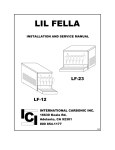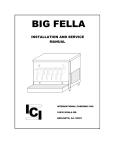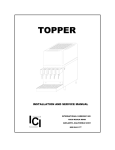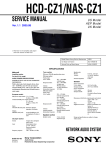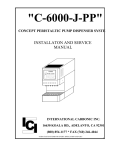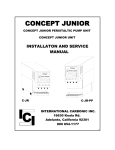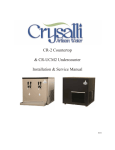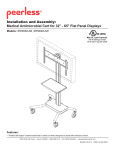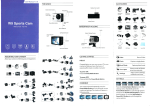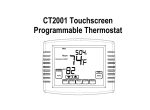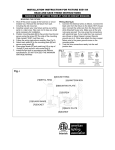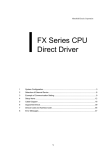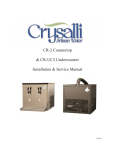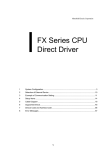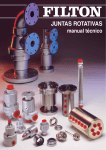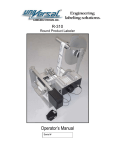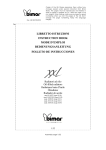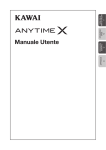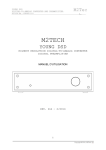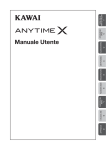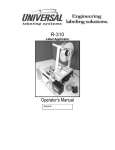Download PREMIX - Soda
Transcript
PREMIX SERVICE AND INSTALLATION MANUAL TOPPER PREMIX ICE COOLED PREMIX TOPPER II PREMIX VSC-II PREMIX BIG FELLA PREMIX CONCEPT PREMIX IC I INTERNATIONAL CARBONIC INC. 16630 Koala Rd. Adelanto, California 92301 800 854-1177 1/00 IMPORTANT: This manual is a guide for installing, operating, servicing and maintaining this equipment. Refer to Table of Contents for page location of detailed information to answer questions that arise during installation, operating, service and maintenance, or trouble shooting this equipment. TABLE OF CONTENTS PAGE Chapter I General Description .............................................................................................................. 1 System Description ............................................................................................................... 1 Premix Design Data ........................................................................................................................... 2 Cooling Unit........................................................................................................................... 2 Overall Cabinet Dimensions ................................................................................................. 2 Weights ................................................................................................................................. 2 Capacities ............................................................................................................................. 2 Refrigerant Requirement....................................................................................................... 2 Electrical Requirement .......................................................................................................... 2 Circuit Ampacity .................................................................................................................... 2 Theory of Operation ........................................................................................................................... 3 The flow of Premix, Mechanical Unit..................................................................................... 3 The flow of Premix, Ice Cooled ............................................................................................. 3 The flow of Carbon Dioxide................................................................................................... 3 Carbonation........................................................................................................................................ 4 Equilibrium Pressure .......................................................................................................................... 6 Operating Pressure ............................................................................................................................ 7 Less Than Equilibrium........................................................................................................................ 8 Over Equilibrium Pressure ................................................................................................................. 8 Changing Product Volumes of CO2 Gas ........................................................................................... 8 Chapter II Installation ......................................................................................................................... 9 Unpacking and Inspection..................................................................................................... 9 Loose Shipped Parts............................................................................................................. 9 Selecting Location................................................................................................................. 9 Location Recommendations for Premix ............................................................................................. 10 Installation ............................................................................................................................. 10 Install Cooling Unit ................................................................................................................ 10 Install High Pressure Premix CO2 Regulator and CO2 Cylinder....................................................... 10 Activate CO2 System ............................................................................................................ 11 Electrical Requirements ........................................................................................................ 11 Chapter III Preparation....................................................................................................................... 12 Preparing and Starting Refrigeration Unit ............................................................................. 12 Daily Pre-Operation Check ................................................................................................... 12 Cooling Unit Maintenance ..................................................................................................... 12 Checking Water Bath ............................................................................................................ 13 Changing Water Bath............................................................................................................ 13 Adjustments .......................................................................................................................... 13 Chapter IV Service and Maintenance ................................................................................................ 14 Periodic Inspection and Cleaning ......................................................................................... 14 Exploded View LF-12 Pre-Mix .............................................................................................. 15 Exploded View Description, LF-12 Pre-Mix .......................................................................... 16 Exploded View LF-23 Pre-Mix .............................................................................................. 18 Exploded View Description, LF-23 Pre-Mix .......................................................................... 19 Exploded View Topper Pre-Mix ............................................................................................ 21 Exploded View Description, Topper Pre-Mix ........................................................................ 22 Exploded View Topper-II Pre-Mix ......................................................................................... 24 Exploded View Description Topper-II Pre-Mix ...................................................................... 26 Exploded View Big Fella Pre-Mix.......................................................................................... 27 Exploded View Description Big Fella Pre-Mix....................................................................... 28 Exploded View Concept Pre-Mix .......................................................................................... 30 Exploded View Description Concept Pre-Mix ....................................................................... 31 Exploded View VSC-II Pre-Mix ............................................................................................. 33 Exploded View Description VSC-II Pre-Mix .......................................................................... 34 Exploded View Pre-Mix Valve............................................................................................... 36 Premix Trouble Shooting.................................................................................................................... 37 Product Will Not Dispense .................................................................................................... 37 Product Foams While Being Dispensed ............................................................................... 37 Frozen Water Bath ................................................................................................................ 38 Condensing Unit Non-Operational ........................................................................................ 38 Compressor Does Not Operate ............................................................................................ 38 Compressor Works Continuously But Does Not Cool Sufficiently........................................ 39 Compressor Will Not Stop After Cooling Pre-mix Product.................................................... 39 Condenser Fan Motor Not Operating.................................................................................... 39 PREFACE INTERNATIONAL CARBONIC INC. has enjoyed over 53 years of manufacturing excellence in the field of carbonation and in the beverage related industry. We have had a long and proud history with quality as our standard and innovation as our goal. Originally started just after World War II in Canfield, Ohio as Carbonic Dispensers. We enjoyed patents on the first Sodajet type carbonator. This method of carbonation instantaneously carbonated the water to 100% saturation. We developed the first patented dispensing valve to dispense bulk beverage with carbonation equal to or in excess of bottled beverages. A valve with three flavors and soda was another first. We were the first to incorporate the total postmix package, i.e., carbonation, refrigeration, and the ability to dispense from one self contained unit. We have pioneered many such firsts and will continue to develop advanced systems for the future, such as electronic interrogatable portion controls to electronic liquid level controls. We hope you enjoy this piece of equipment that has been produced to give many years of trouble free service. We thank you for your purchase and hope we may serve you in the future. CHAPTER I GENERAL DESCRIPTION This chapter gives the description, theory of operation, and design data for PREMIX units and related components. A PREMIX unit can be manufactured as a LF-12, LF-23, BIG FELLA, TOPPER, TOPPER-II, CONCEPT-6000 VSC-II or in a variety of ice cooled type cold plate systems. Special application PREMIX units can be manufactured on request, contact factory. SYSTEM DESCRIPTION A PREMIX unit will cool and dispense a carbonated beverage that has been carbonated and mixed in a proper syrup ratio in a location other than the point of sale. PREMIX locations are normally set up for short duration dispensing were it is impractical to install a post mix unit. A PREMIX install is normally reserved for special events were the volume of draw will be to great to handle with bottle and cans. The PREMIX refrigerated unit consists of a cabinet, condensing unit, a water bath, product cooling coils, (one for each product), an agitator pump, and dispensing valve(s). Ice cooled units consists of a cabinet, dispensing valves, cold plate with individual passes for each flavor. For proper function the PREMIX unit only requires an electrical supply for mechanically refrigerated models and drainage. For proper function ice cooled units will require drainage, but the availability of electricity is not necessary. Other items that will be required to perform a functional installation will be a CO2 supply, a premix pressure regulator, connecting lines, and quick disconnects. WARNING: Before shipping or relocating a PREMIX unit into a freezing ambient environment drain and relieve all pressure from individual premix passes in unit. A freezing ambient environment will cause existing product in unit to freeze possibly resulting in damage to individual passes. 1 TABLE I - I PREMIX DESIGN DATA COOLING UNIT Overall cabinet dimensions: LF-12 Height Width Depth 23 ½ 12 26 LF-23 TOPPER T-II 23 ½ 23 12 ¾ 30 13 ¼ 19 ½ 32 ½ 15 ¾ 21 ½ BF CONCEPT-6000 VSC-II 33 ¼ 16 ¾ 22 ¾ 33 16 3/8 24 1/2 29 ¼ 26 ½ 16 ½ Weights: LF-12 Shipping Dry Operational Ice Bank 115 90 123 9.5 LF-23 TOPPER 115 90 123 9.5 115 90 132 12 T-II 142 108 199 30 BF CONCEPT-6000 145 117 183 35 174 132 232 35 VSC-II 173 141 250 50 Capacities: Unit water bath (no ice bank) gallons LF-12 4 LF-23 4 TOPPER 5 T-II 11 BF 7 CONCEPT-6000 12 VSC-II 13 Refrigerant requirement (R-134-A) grams LF-12 LF-23 TOPPER T-II BF 165 165 155 184 250 Ambient operating temperature CONCEPT-6000 350 VSC-II 258 40 F to 100 F. Electrical Requirements: The cooling unit requires a 115 VAC, single phase, 60 Hertz power circuit. Circuit Ampacity LF-12 Unit total Condensing Unit Agitator 3.5 2.5 1 LF-23 3.5 2.5 1 TOPPER T-II 3.5 2.5 1 6.0 5.0 1 Ambient Operating Temperature 40 F to 100 F 2 BF 7.8 6.8 1 CONCEPT-6000 7.8 6.8 1 VSC-II 7.8 6.8 1 THEORY OF OPERATION The PREMIX unit was designed to cool and dispense a carbonated beverage that has been manufactured at your local bottling plant. The premix product is contained and transferred in a five-gallon transfer tank referred to as a FIGAL. The FIGAL is kept under pressure with CO2 and should remain under pressure at all times. The pressure in the tank will vary with the ambient temperature. If a premix FIGAL is stored in a very cold location the amount of carbonation, refereed to as volumes of CO2, may increase in the premix product. This increase in carbonation will not happen instantly but will occur over a long period of time. The ideal volume to dispense the premix product is 3.5 or 3.6, any higher in volumes will cause foamy drinks. The flow of the PREMIX product from the FIGAL through a mechanically refrigerated unit is as follows: The product flows through the outlet on the FIGAL, through a quick disconnect into and through the beverage tubing entering the unit. The product flows through ¼” inner braid tubing, until it reaches a submerged cooling or premix coil. This coil is submerged in a water bath that is kept at a temperature of approximately 32.5 degrees. As it passes through this cooling coil the temperature of the premix product is greatly reduced until the temperature is sufficient to dispense a quality drink. The product is finally routed through a premix faucet. The volume of flow will be controlled by an adjustment on the premix faucet. The number of premix coils will depend on the number of flavors required and space available. The flow of the PREMIX product from the FIGAL through an Ice Cooled unit is as follows: The product flows through the outlet on the FIGAL, through a quick disconnect into the beverage tubing entering the unit. The product flows through ¼” inner braid tubing until it reaches a stainless steel serpentine coil incased in 99.7% pure aluminum, (the cold Plate). This serpentine coil refereed to as a pass will be of sufficient length to cool the premix product to a sufficient temperature to dispense a quality drink. The number of passes in a cold plate will depend the number of products to be cooled, required length of pass and space available to accommodate the cold plate. For the cold plate to function, ice must cover the cold plate. As the premix product passes through a pass the temperature of the premix product is greatly reduced until the temperature is sufficient to dispense a quality drink. The product is finally routed through a premix faucet. The volume of flow will be controlled by an adjustment on the premix faucet. Never use ice directly from a freezer. THE FLOW OF CARBON DIOXIDE GAS (CO2) Carbon dioxide gas (CO2) passes from a C02 cylinder through high-pressure premix regulator. The high-pressure premix regulator should be set at a sufficient pressure to keep equilibrium pressure for the premix product. The gas, after leaving the high-pressure premix regulator is routed to individual FIGALS. The average settings may vary this of course will be influenced by temperature and length of run. 3 CARBONATION Volumes of carbonation is the amount of gas that is dissolved in the carbonated beverage. This is determined by temperature and pressure and can be read by the use of a Carbonation Tester. The volume means simply the relative bulk of gas dissolved in the liquid and, although it seems odd that several bulk volumes of gas will disappear into one bulk volume of water, yet this is a phenomenon known as gas solution. To bring about the gas solution, pressure is needed, and when the pressure is released on the gas, out it comes again. When the pressure of the carbon dioxide gas is only that of the atmosphere in which we live, we find that the gas dissolves in amounts determined by the temperature of the water. Gas will dissolve without pressure from 1.71 volumes at the freezing temperature of water to 0.56 volumes at 100 degrees F. To get greater amounts of carbon dioxide into solution, it is necessary to increase the pressure of the gas on the water. This is indicated on a carbonation tester by the increase in volumes and the gauge pressure begins at zero, (which is atmospheric pressure), and proceeds on to 30 pounds per square inch. The important thing to notice is that every time the gas pressure is increased by 14.7 pounds per square inch, the gas content increases on multiple of the atmospheric pressure, for a given temperature. For example, we find that at 60 degrees F. one volume of carbon dioxide will dissolve in one volume of product at atmospheric pressure, (zero #/sp. In. on gauge). Then as the gauge pressure reaches 14.7, the amount of gas dissolved becomes 2.0 volumes, at 29.4 the amount of gas is 3.0 volumes. At 44.1 the amount of gas is 4.0 volumes, etc. This same multiple ratio of solubility holds true at normally used temperatures and pressures. In practice, the amounts of gas wanted are such that pressure is needed to get the amounts of “load” of carbon dioxide in the liquid and by such process the gas is placed in a “tension” in the liquid, and is held there by the pressure placed on it. To a certain extent, this is the same as placing pressure on a long, coiled spring and compacting it. As long as the pressure is maintained, it stays compacted, but as the pressure is released, it uncoils regularly until all of this load tension is gone. So it is with carbonated liquids – the gas content or “load” is held in by pressure creating a tension on the gas in the liquid so that when the pressure is removed, (when the bottle is opened), the gas moves out of the liquid until it is back to the original conditions before the pressure was applied. The next important consideration is the effect that the varying degrees of carbonation will have on the finished beverage, its appearance, taste, and general behavior. Depending somewhat on the type of beverage, carbonation much above 3.5 volumes tend to throw off too much carbon dioxide in the mouth and throat, causing choking or irritation. It is quite satisfactory, therefore, to say that for the majority of products it is not necessary to have over 3.5 volumes of gas in the beverage at the time it is going into the consumer’s mouth, to give the most desirable pungency or taste sensation. However, since there is always some gas lost when the drink is poured an additional gas content must be considered. The amounts of carbon dioxide lost as a beverage is dispensed vary. The gas loss is negligible when the product has been cooled and not unduly disturbed. However, when the beverage is poured into a glass, mechanical agitation takes place that more or less tends to throw the gas out of the liquid. As long as the gas loss in pouring does not become so great that the resulting beverage has dropped below the reasonable taste range and becomes dead, it is not wasted, for the bubbles formed furnish a direct eye appeal. It is not uncommon to find that from 0.5 to 3.0 or more volumes of gas have been lost just in the dispensing. The more agitation that occurs from either having a spoon or cracked ice in the glass or pouring from a higher point that just at the lip of the glass tends to increase the gas loss, and is often the 4 cause of flatness. It’s important to note at this point that the temperature of the beverage greatly influences the amount of gas loss by agitation, the tendency being that the lower the temperature of the beverage, the more stable it is. It is far better to pour a cold beverage over cracked ice than to try to pour warm beverage in the same manner and depend on the ice to do the cooling. The latter case the disturbance will take place in the carbonated beverage before it has time to be cooled, and gas loss will occur. Once the beverage is placed in a glass it should have at least enough carbonation to show some life during the period in which the beverage is being drunk, the carbonation being part of its appeal, and lastly it must still possess its necessary pungency to the taste. If by chance it is mixed with other liquids that are not carbonated, they will absorb some of the gas from the beverage and will thereby tend to dilute and lower the general carbonation. In general, it has been found that if the beverage is finally quiet in the glass after the disturbance of dispensing with from 2.5 to 3.5 volumes of carbonation, it will not be lifeless. As will be shown later, attempting to get more than this amount in the glass is not feasible. As an example, a very fine quality sparkling water was run in the Technical Service Laboratory of the NSDA to see how it behaved during these handling steps. Using a special procedure, the gas content of the water was determined at all steps. Using clean, cooled glasses of ordinary size, here are the results obtained: Conditions Orig. Carb. Very carefully Average Poured over cracked ice #1 42 Degrees F. fine 4.5 4 3.4 2.3 Carbonation Retention Tests #2 82 Degrees F. fine 4.5 3.1 2.1 1.7 #3 42 Degrees F. Fine #4 42 Degrees F. foreign particles 5.5 4.1 3.2 --- 5.5 3 2.6 2.1 From the results shown in column #1, it is obvious that with the best of conditions there is still considerable loss of gas serving, particularly if the beverage gets badly agitated in the glass. Note: Product of very high quality could be made inferior by careless serving. Another factor can be easily shown by the figures in column #2, namely, the effect of temperature on the behavior of the product. Using another bottle of fine sparkling water, the same routine was carried out, differing only in that the water was at room temperature of 82 degrees F. From this example, it is quite obvious that it is wise to serve a carbonated beverage well cooled, and that it is particularly undesirable to try to cool it by using cracked ice. The question arises as to what would happen if the carbonation of this product was raised, and therefore, some of the same water was carbonated to 5.5 volumes, see column #3 on table. With this carbonation, the water was found to be very touchy, if not “wild”, and threw off an excessive amount of gas during the dispensing. Even with the higher original carbonation, the best that could be obtained when cooled to 42 degrees F. and poured with 5 great care into a glass was a gas content in the glass of 4.1 volumes, which compared with the 4.0 volumes resulting in the first experiment using the lower carbonation. But the interesting fact came when this higher carbonated water was poured in an average manner into a glass, for the carbonation remaining after pouring dropped to 3.2 volumes, which showed a difinte loss as compared to the 3.4 volumes in the final glass of carbonated water using the lower carbonation. Boosting the carbonation made the product poured out in the glass less lively than before. The natural question is, why cannot more gas be put in a beverage be yound a reasonable amount to obtain better life? The answer lies in the “load” of gas which exerts a very definite strain or tension in the liquid as it is served. In another test, a sparkling water which showed suspended matter obvious in the bottle when the water was examined by a strong cross lighting was run in the same manner as was the first water mentioned. This latter water was the same carbonation as before, 4.5 volumes and the water was poured into the glasses at a temperature of 42 degrees F. When these results are compared with the sparkling water first mentioned, it becomes quite obvious that the particles suspended in the water had a very destructive effect on the carbonation. These particles are generally spoken of as nuclei on which bubbles form, and experimentally with unusually clean apparatus, it has been possible to go to excessive carbonation without any tendency for bubbles to form when the pressures are released. It is, therefore, believed that in the majority of cases these particles are necessary to let the gas unload, and that those particles showing negative charge are the most likely to cause this phenomenon, for some particles without the necessary charge will not cause bubbles to form. To observe on any given product, the reasonably cool bottle should be opened quietly by taking the crown off slowly, (the bottle should also have stood quietly for at least 15 minutes before the test). Then with cross lighting watch to see where bubbles of gas form. Where the water is extremely clear and bright, and the bottle well washed, with a clean inner surface, bubbles will form a very slow bubbling. If, however, there are a number of active particles or nuclei present, bubbles will form rapidly in the body of the liquid. Particles may even be seen dancing around in the liquid, with a feather or stream of bubbles arising as they do. If the bottle is dirty, the bubbles will form at excessive rates on the glass surface. In general, the elimination of such difficulties is through better clarification of the water used, or better cleaning of the inside of the container the product is carried in or dispensed into. To show how particles affect a product, flick some salt in a well carbonated beverage and watch the rapid gas loss. The sharpened end of a lead pencil will have the same effect. A very logical question is often asked as to whether or not there is any way that the gas can come out of carbonated beverages than through bubbles. The answer is that the gas can leave by a substantially invisible process known as diffusion, in which the gas moves slowly through the open surfaces of the beverage and into the surrounding atmosphere. Diffusion will cease as soon as the pressure have equalized. It may be said that the indication of how fast the beverage is losing its gas is directly indicated by the speed of bubble formation. Then it can also be said that rapid bubble formation in a beverage may indicate life at the particular moment, but the product which will stay alive the longest on standing is one which may appear almost dead and will bubble only when disturbed. Even though the bubbles forming at any one time appear to have only a small volume, they rapidly amount to an appreciable amount of gas. EQUILIBRIUM PRESSURE A FIGAL that has counter or head pressure of equilibrium is one that has pressure just sufficient to keep the recommended volume of CO2 gas absorbed in the product at a particular product temperature. 6 This equilibrium pressure is not a constant. It varies with the change in the product temperature. As the product temperature increases, equilibrium pressure also increases. This is caused by the fact that a container of water without any head pressure will absorb 1.71 volumes of CO2 gas at 32 degrees F. and on .56 volumes of CO2 gas at 100 Degree F. If the pressure is not increased as the product temperature rises, the product will lose .017 volumes of carbonation per degree of temperature rise. OPERATING PRESSURE Operating pressure is equilibrium pressure plus enough pressure to overcome pressure loss or resistance caused by the peculiarities of any specific system. Some of the peculiarities encountered that offer a system resistance are, (a) Manifolding together of more than one tank of product in the system. (b) Operating pressure may have to pump product through lines of a considerable distance. (c) Operating pressure may have to lift the product in a vertical lift, such as from the first floor product storage to a second floor unit installation. For these reasons, the correct operating pressure for any specific system must be determined according to the peculiarities of the equipment installation. Experience has indicated that for the simplest of installations where the product lines are short, not more than two or three tanks of product are connected in a series at one time, and the tanks are on the same floor as the dispensing apparatus, setting the operating pressure at five pounds more than equilibrium pressure is usually a good rule of thumb. In the case of the above system, if the product is carbonated at 3.6 volumes and the product temperature is 70 degree F., forty-eight pounds is equilibrium pressure and fifty-three pounds would be operating pressure. It is suggested that five pounds additional pressure be used as a starting point to which should be added amounts of pressure to compensate for more rugged conditions than those in the above example. For instance, if the tanks are located on the floor below the dispensing station, one pound of pressure should be added to our standard amount of five pounds for every two feet of vertical distance between the top of the FIGAL and the dispensing valves on the floor above. If, for example, this distance were to be ten feet the resulting five pounds additional pressure should be added to our standard five, bringing the total to ten pounds of additional pressure to be added to the equilibrium pressure in order to obtain the operating pressure for our CO2 regulator. In this same example, if the product lines between the FIGAL and the unit are quite long, approximately one pound of additional pressure should be added for every ten feet of product line over a basic length of ten feet, which is compensated for in the original standard addition of five pounds; Therefore, if the product lines are thirty feet long, two additional pounds should be added to the ten pounds already arrived at for this example. If, in addition, the above installation required five FIGAL’s in one series rather than the average of three or less, one pound should be added to the previous result of twelve pound for each additional tank over three. In this example, if two pounds were added to the original twelve pounds, then the proper operating pressure for this system would be fourteen pounds above equilibrium pressure. In determining the equilibrium pressure for a product in an installation, the highest temperature encountered by the product between the tank storage area and the cooling source must be considered. It should be remembered that the above rules are not absolute, but have evolved, for the most part, from experience. While these rules will generally hold true, they should be considered as merely a starting point for further experience and common sense in dealing with 7 the many abnormal conditions often found in the customers place of business. LESS THAN EQUILIBRIUM Attempting to dispense product at less than equilibrium is probably the greatest cause of foaming complaints and flat product. Foaming generally occurs when operating pressure is slightly lower than it should be or when the cooling unit is not doing an adequate job and the product is being dispensed in most cases above forty degrees F. Spitting at the dispensing valve is usually caused by operating pressure being considerably lower than it should be. In the case of spitting, gas is leaving the product rapidly in the form of large bubbles not only during dispensing, but also while the system is at rest. These large bubbles will flow to the highest points in the product line or cooling unit and form gas pockets. Spitting occurs when these gas pockets are forced through the lines and arrive at the dispensing valve. Even though the cooling unit lowers the product temperature so that the equilibrium pressure is lower, there is no way of putting the CO2 gas back into the product while it is in the lines. OVER EQUILIBRIUM PRESSURE Pressure in excess of equilibrium can in a period of time change the volume of CO2 gas held by the product. As mentioned under “equilibrium Pressure,” temperature of the product has a great effect upon the acceptance or rejection of CO2 gas by the product. As and example, if the product were stored in a cool area and the product temperature is 45 degree F. and equilibrium pressure is exceeded by ten pounds, then the product CO2 volumes would be increased by .8 in approximately 16 hours if this is a 3.6 volume product to begin with. If the product is a 4.0 volume product, then it increases .9 in approximately 16 hours. According to the temperature rule, if the product temperature were lower than 45 degrees and the over-pressure greater than ten pounds, the increase in the product carbonation would be greater in a shorter period of time. Since 70 degree product carbonated at 3.6 volumes will pick up only .53 volumes of gas in approximately sixty hours and 4.0 volume product in the above example picks up only .55 volumes in sixty hours, it is, therefore, a good practice especially when substantial overpressures are required to place the product tanks in as warm an area as possible. Warm product will gain fewer volumes and require a longer period of time for absorption than cold product, given the same amount of over pressure. CHANGING PRODUCT VOLUMES OF CO2 GAS If the product should be found “flat” the volumes of CO2 gas can be increased to the recommended volumes by finding equilibrium pressure for the temperature of the product. Set this pressure on the CO2 regulator, attach gas line to the product tank, and shake the tank vigorously until CO2 gas is no longer heard entering the tank. The lower the product temperature, the less shaking will be required to bring product volumes of CO2 to recommended point. If product should be found “over-carbonated”, then excess volumes can be released by relieving the head or counter-pressure in the product tank. After this is done, shake the tank vigorously: this causes product to give off CO2 gas to replace pressure in headspace. If the product is only slightly over-carbonated, then usually one such operation is all that is required. Be sure to test, and if required, repeat operation of relieving counter-pressure and releasing CO2 gas from product until recommended volumes are obtained. If a full tank has the head pressure released and then is shaken, the gas released to replace the head pressure will reduce the product carbonation by approximately .2 of a volume if the product was 4.0 volume. 8 CHAPTER II INSTALLATION This chapter covers unpacking, inspection, selecting location, installing PREMIX UNITS and related components and electrical requirements. UNPACKING AND INSPECTION Upon receiving unit, immediately remove unit from shipping carton and inspect for shipping damage. NOTE: Before leaving the factory all PREMIX units were carefully inspected and the carrier has accepted and signed for them. Any damage or irregularities should be noted at the time of delivery and immediately reported to delivering carrier. Request a written inspection report from claims inspector to substantiate any necessary claim. File claim with delivering agency, not International Carbonic Inc.! Unpack LOOSE-SHIPPED PARTS. At this time make sure all parts listed are present and in good condition. If any parts are missing, notify factory. TABLE 2-1 LOOSE - SHIPPED PARTS MODEL II S-1149 Drip Tray S-1149A Cup Rest S-1150 Drip Tray S-1150A Cup Rest S-1156 Drip Tray S-1156A Cup Rest S-1157 Drip Tray S-1157A Cup Rest S-1158 Drip Tray S-1158A Cup Rest PMR-4 (Reg. Assembly) PMR-5 (Reg. Assembly) Decals Service Manual LF-12 LF-23 X X TOPPER T-II BF CONCEPT-6000 VSC- X X X X X X X X X X X X X X X X X X X X X X X X X X X X X X X X X SELECTING LOCATION IMPORTANT: Ambient temperature for PREMIX should not exceed 100 degrees “F”. Operation of cooling unit in ambient above 100 degrees “F” can and will contribute to early failure of condensing unit and poor quality of finished product. 9 LOCATION RECOMMENDATIONS FOR PREMIX 1. Position unit as close as possible to proper electrical source, 115V 60HZ, not applicable to ice cooled units. 2. Position unit with a minimum of 2” space between bulkhead and cabinet for sufficient space for ventilation. Allow enough space between ceiling and unit for lid removal. 3. Enough space must be allowed to install C02 cylinder, product FIGAL’s as close as possible to serving unit. FIGURE 2-1. SAMPLE OF POSSIBLE INSTALLATION. INSTALLATION INSTALL COOLING UNIT 1. Make all connections: C02 gas, drains, and premix product. 2. Place PREMIX unit in position. Make sure sufficient space between bulkheads, walls and overheads is available for proper air circulation around cooling unit, not applicable to ice cooled units. INSTALL HIGH PRESSURE PREMIX C02 REGULATOR, AND C02 CYLINDER 10 1. Install high pressure premix C02 regulator (PMR), on C02 cylinder using a new seal gasket. MAKE SURE NEW WASHER IS INSIDE REGULATOR ASSEMBLIES COUPLING NUT BEFORE CONNECTING TO CYLINDER. WARNING-: To avoid personal injury and/or property damage, always secure C02 cylinder with safety chain to prevent cylinder from falling. It is recommended that C02 cylinder be installed away from heavily traveled areas such as doors, passageways, corridors, etc. ACTIVATE C02 SYSTEM 1. Open valve on the C02 cylinder. Be sure to open valve completely or until valve is back seated. Note: Make sure PMR’s pound per square inch indicator is not in shaded portion of dial. If so, C02 cylinder is almost empty and must be replaced. This reading should be carried out at normal room temperature. 2. Turn PMR adjustment screw clockwise until the pressure is set to proper setting, refer to EQUILIBRIUM PRESSURE, Chapter 1. 3. Check all connections on PMR C02 system for leaks. Repair any leaks that are found. 4. The premix PMR-assembly is provided with individual gas lines and quick disconnects. ELECTRICAL REQUIREMENTS: The PREMIX requires a 115 VAC, single phase, 60 Hertz power circuit, and must be wired in accordance with N.E.C. or local ordinance. NOTE: Check CHAPTER I for running amperage and connect to appropriate electrical circuit. 11 CHAPTER III PREPARATION All steps in previous chapters should be understood and carried out before proceeding. PREPARING AND STARTING REFRIGERATION UNIT 1. PREMIX unit refrigeration is pre-set at factory and ready to operate. 2. Remove lid. 3. For water bath units fill water bath with clean water until water runs out of condensate drain outlet above drain pan (approximately ½” from top of water bath). Do not over fill unit so as to allow water to drain from overflow. 4. For ice cooled units fill ice bin with ice, never use sub-cooled ice. 5. Plug PREMIX power cord into electrical receptacle box, turn power switch to the "ON" position. Make sure compressor, condenser fan motor, and agitator motor start. The process of cooling the water bath will now commence. With ambient and water temperature of 75 degree “F” initial pull down or formation of complete ice bank will take approximately 3 to 5 hrs respectfully. When full ice bank has been formed, compressor and condenser fan motor will stop. Agitator will continue to operate, circulating water in water bath. DAILY PRE-OPERATION CHECK Make sure there is a sufficient premix product supply in all FIGAL containers. If not, replenish. COOLING UNIT MAINTENANCE NOTE: Air circulation through the condenser coil, required to cool the condenser coil/compressor, is drawn in through grills on the sides, top and or front of the cooling unit, through condenser coil and is exhausted out grills on the back side of the unit. Restricting air circulation through the cooling unit will decrease its cooling capacity. To avoid needless and sometimes costly repairs, it is imperative to keep condenser fins clean. This may be accomplished by one of three methods. One method is use of a condenser brush (a longhaired, soft bristle brush) to gently sweep fins of condenser clean. Second method is to use a strong vacuum. The third method is to use C02 or an air hose to blow out condenser. The latter method should only be attempted after normal business hours to avoid dust contamination. 12 CHECKING WATER BATH Periodically check water level in water bath. If it is low more water should be added as instructed for maximum product cooling. This dehydration will normally not occur in normal temperate climate zones. With normal humidity the opposite will occur therefore a condensate drain is installed. Any extra water in the water bath will exit the unit via the drain outlet. When unit is building it's first ice bank it is normal to have water overflow into the drain hose. CHANGING WATER BATH Drain water bath a minimum of twice a year. This can be accomplished by siphoning water with short hose into bucket. Once water is drained and ice bank is melted, water bath, water coils, bath walls, tank, etc. should be cleaned. Fill water bath to within 1/2" of the top of the water bath. ADJUSTMENTS Periodically premix regulators should be checked for proper pressure settings and if necessary, adjust as instructed. These settings can be recorded in NOTE section of this manual. 13 CHAPTER IV SERVICE AND MAINTENANCE This chapter describes service and maintenance procedures to be performed on PREMIX units and related components. PERIODIC INSPECTION AND CLEANING Daily: 1. Clean any syrup from storage tanks, connecting sockets and general syrup storage area with warm water. 2. Check the C02 gas supply. If cylinder pressure is below 500 P.S.I., replace the cylinder. NOTE: Readings should be taken at normal room temperature, approximately 70 degrees “F” and above. If C02 cylinder is stored in a walk-in refrigerator, the P.S.I. indicator will read below 500 psi even when cylinder is full. 3. Check the C02 gas pressure supplying the FICAL’s. These pressures should not change. If a change occurs repeatedly, contact your local service agency. It is suggested to make a comment about this occurrence in NOTE SECTION of manual. 4. Clean the beverage dispensing area. 5. Wipe exterior of unit with a warm moist towel, never an abrasive cleaner. Weekly: 1. Order premix product to maintain proper inventory. 2. Check all C02 gas connections for leaks. 3. Check condenser coil for obstructions or dirt. Monthly: 1. Clean condenser fins or filter to make sure the refrigeration unit has adequate air flow. 2. Inspect components of cooling unit water bath for cleanliness. 3. Check entire system for leaks or damaged components. Repair as necessary. 4. Remove ice from cold plate and clean cold plate. 14 4 1 8 9 5 2 10 6 12 11 13 7 14 15 3 16 19 27 17 18 25 20 26 21 24 22 23 28 29 30 31 32 35 34 36 33 37 38 40 39 16 43 42 41 INTERNATIONAL CARBONIC INC. ICI 44 45 ADELANTO, CALIFORNIA 15 TITLE LF-12 PRE-MIX DATE 1/7/05 DRN. BY CHK. BY APPR. BY GLW LF-12 PREMIX SYM QTY PART NO. DESCRIPTION 1 1 S0770 LID W/INSULATION 2 1 S0750 SERVICE PANEL, REAR 3 2 S0751 SERVICE PANEL, SIDE 4 1 G0016 TY-RAP, LARGE 5 1 S0835 AGITATOR PUMP 6 4 S0992 PREMIX COOLING COIL 7 2 S0993 PREMIX COIL BASKET 1 S0991 PREMIX COOLING COIL ASSY, S-992 AND S993 8 2 S0741 EVAPORATOR COIL RETAINER 9 1 S0509 ACCUMULATOR 10 1 S0739 STAND PIPE, 6 1/2", WHITE 11 1 S0738 OVERFLOW, 6 3/4", GRAY 12 1 S0733 EVAPORATOR COIL ASSEMBLY 13 1 ..... CAP TUBE, 12' - .042 14 1 S0731 BUCKET COMPLETE W/INSULATION 15 1 S0513-A 16 9 A0020 17 1 S1304-U 18 1 ..... INSULATION, REAR 19 1 ..... INSULATION LEFT 20 1 ..... INSULATION RIGHT 21 1 ..... INSULATION, FRONT 22 1 ..... INSULATION, BOTTOM 23 1 ..... MOISTURE BARRIER - 12 ICE BANK CONTROL 8-32 X 3/8 T.H. SCREWS, S.S. ICE BANK CONTROL, PROBE BRACKET 16 LF-12 PREMIX Cont. SYM QTY PART NO. DESCRIPTION 24 1 ..... MOISTURE BARRIER - 23 25 1 S0732 FRAME, COMPLETE 1 AEA1360YXAXA 1 AEA1360YXA 27 2 A0046 28 4 10-2009-10 YOKE, O.135 BARB 29 1 S0765 LEGS, 4", SET OF 4 30 1 S0783 UNIT ON OFF SWITCH 31 4 S0918 PREMIX VALVE ADAPTER 32 4 PMV 33 1 S0769 VALVE PLATE 34 2 A0049 SCREW, 8-32 X 3/8 PHILL PH 35 1 S1308 CONTROL BOX W/COVER 36 5 S0046 BUSHING 37 2 S-7/8 HOLE PLUG 38 1 S1310 CONTROL BOX COVER 39 1 S1309 TERMINAL BOARD 40 4 S1335 TERMINAL BOARD SPACER, NYLON, 3/8" 41 1 E0664 STRAIN RELIEF 42 1 E0141-12 CORD 43 1 S1149-A CUP REST 44 1 S1149 DRAIN PAN W/CUP REST 45 1 S0743 DRAIN PAN HARDWARE, SET CONDENSING UNIT, 1/5 H.P. 26 COMPRESSOR ONLY 5/16 X 18 FLANGE WHIZ LOCK SCREW, 3/4" PREMIX VALVE 17 4 1 3 5 2 6 7 10 8 11 2 9 12 13 15 14 16 17 23 18 19 20 24 21 22 26 25 29 33 28 32 31 27 34 30 41 38 36 37 39 11 42 35 40 INTERNATIONAL CARBONIC INC. ICI 43 44 ADELANTO, CALIFORNIA 18 TITLE LF-23 PRE-MIX DATE 1/7/05 DRN. BY CHK. BY APPR. BY GLW LF-23 PREMIX SYM QTY PART NO. DESCRIPTION 1 1 S0780 LID W/INSULATION 2 2 S0751 SERVICE PANEL,SIDE 3 1 S0750 SERVICE PANEL, REAR 4 2 S0993 PREMIX COIL BASKET 5 4 S0992 PREMIX COOLING COIL 1 S0991 PREMIX COOLING COIL ASSY., S-992 & S-993 6 2 S0741 EVAPORATOR COIL RETAINER 7 1 S0509 ACCUMULATOR 8 1 S0733 EVAPORATOR COIL ASSEMBLY 9 1 ..... CAP TUBE, 12' - .042 10 1 S0513-A ICE BANK CONTROL 11 9 A0020 12 1 S1304-U 13 1 S0739 STAND PIPE, 6 1/2", WHITE 14 1 S0738 OVERFLOW, 6 3/4", GRAY 15 1 G0016 TY-RAP LARGE 16 1 S0835 AGITATOR PUMP 17 1 ..... INSULATION, LEFT SIDE 18 1 ..... INSULATION, REAR 19 1 ..... INSULATION, RIGHT SIDE 20 1 ..... INSULATION, FRONT 21 1 ..... INSULATION, BOTTOM 22 1 ..... MOISTURE BARRIER 8-32 X 3/8 T.H. SCREWS, S.S. ICE BANK CONTROL PROBE BRACKET 19 LF-23 PREMIX Cont. SYM QTY PART NO. DESCRIPTION 23 1 S0731 BUCKET COMPLETE W/INSULATION 24 1 S0732 FRAME, COMPLETE 25 1 S0783 UNIT ON OFF SWITCH 26 4 10-2009-10 27 4 PMV 28 4 S0918 PREMIX VALVE ADAPTER 29 1 SET S0765 LEGS, 4", SET OF 4 30 1 S0779 VALVE M0UNTING PLATE 31 2 A0049 SCREW, 8-32 X 3/8 PHILL PH 32 1 S1308 CONTROL BOX W/COVER 33 1 E0141-12 34 5 S0046 BUSHING 35 2 A0046 5/16 X 18 FLANGE WHIZ LOCK SCREW, 3/4" 36 1 S1310 CONTROL BOX COVER 37 4 S1335 TERMINAL BOARD SPACER, NYLON, 3/8" 38 2 S-7/8 HOLE PLUG 39 1 S1309 TERMINAL BOARD 40 1 E0664 STRAIN RELIEF 41 1 AEA1360YXAXA 1 AEA1360YXA 42 1 S1150-A 43 1 S0743 DRAIN PAN HARDWARE, SET 44 1 S1150 DRAIN PAN W/CUP REST YOKE, 0.135 BARB PREMIX VALVE CORD CONDENSING UNIT, 1/5 H.P. COMPRESSOR ONLY CUP REST 20 1 2 3 5 4 6 8 7 21 9 16 10 11 13 12 22 12 14 17 15 19 18 23 26 20 27 33 24 28 29 31 30 25 34 32 35 36 41 37 38 INTERNATIONAL CARBONIC INC. 39 ICI 40 ADELANTO, CALIFORNIA 21 TITLE DATE TOPPER PRE-MIX 1/7/05 DRN. BY CHK. BY APPR. BY GLW TOPPER PREMIX SYM QTY PART NO. DESCRIPTION 1 1 S0777 2 1 S0776-G TOP GRID 3 1 S0776-V REAR VENT 4 1 S0775 COVER ONLY S0774 ITEMS 1,2,3, AND 4, (COMPLETE COVER) NYLON FASTENER 5 4 S0996 PREMIX COOLING COIL 6 1 S0997 PREMIX COIL BASKET S0995 PREMIX COOLING COIL ASSY., S-996 & S-997 7 2 A0049 SCREW, 8-32 X 3/8 PHILL HD 8 1 S1308 CONTROL BOX WITH COVER 9 5 S0046 BUSHING 10 1 S-7/8 HOLE PLUG 11 1 S1310 CONTROL BOX COVER 12 5 A0020 8-32 X 3/8 T.H., S.S. SCREW 13 1 S1309 TERMINAL BOARD 14 4 S1335 TERMINAL BOARD SPACER, NYLON, 3/8" 15 1 E0664 STRAIN RELIEF 16 1 S0513-A ICE BANK CONTROL 17 1 S1304-U ICE BANK BULB BRACKET 18 3 S1323 EVAPORATOR GUIDE WEDGE 19 1 G0016 TY-RAP LARGE 20 1 S0835 AGITATOR PUMP 21 2 A0046 5/16 X 18 FLANGE WHIZ LOCK SCREW, 3/4" 22 TOPPER PREMIX Cont. SYM QTY PART NO. 22 1 AEA1360YXAXA AEA1360YXA DESCRIPTION CONDENSING UNIT, 1/5 H.P. COMPRESSOR ONLY, 1/5 H.P. 23 1 ..... CAP TUBE, 12' - .050 24 1 S0509 ACCUMULATOR 25 1 S0796 EVAPORATOR COIL ASSEMBLY 26 3 S0795 EVAPORATOR COIL RETAINER 27 3 S0793 EVAPORATOR SUPPORT BRACKET 28 1 S0781 CONDENSER MOUNTING BASE 29 1PR S0681 SUPPORT HINGE 30 1 S0778 STANDPIPE 31 1 S0799 WRAPPER & BUCKET ASSEMBLY W/INSULATION 32 1 S0766 UNIT ON/OFF SWITCH 33 4 10-2009-10 34 1 S0789 VALVE MOUNTING PLATE 35 4 S0918 PREMIX VALVE ADAPTER 36 4 PMV 37 1 S1156-A 38 1 S1156 DRAIN PAN W/CUP REST 39 1 SET S0743 DRAIN PAN HARDWARE, SET 40 1 E0141-12 41 1 S0765 YOKE, 0.135 BARB PREMIX VALVE CUP REST CORD LEGS, 4", SET OF 4 23 1 2 3 4 4 5 2 18 12 6 17 19 13 7 8 10 14 9 11 15 21 20 38 16 22 30 29 31 23 26 25 24 27 44 37 32 28 33 34 7 35 36 39 40 41 43 42 48 49 INTERNATIONAL CARBONIC INC. ICI 45 46 47 ADELANTO, CALIFORNIA 24 TITLE DATE TOPPER-II PRE-MIX 1/7/03 DRN. BY CHK. BY APPR. BY GLW TOPPER-II PREMIX SYM QTY 1 1 PART NO. S0777 DESCRIPTION NYLON FASTENER 2 2 S0725-V FRONT AND REAR VENT 3 1 S0725-G TOP GRID 4 2 S0725-L SIDE LOUVER 5 1 S0724 COVER ONLY 1 S0709 ITEMS 1,2,3,4, AND 5, (COMPLETE COVER) 6 1 S0513-A 7 5 A0020 8 1 S1304-U 9 2 F0004 10 1 S0697-LG 11 1 S0835-L AGITATOR PUMP 12 1 S0994-5 PREMIX COOLING COIL, #5 13 1 S0994-4 PREMIX COOLING COIL, #4 14 1 S0994-3 PREMIX COOLING COIL, #3 15 1 S0994-2 PREMIX COOLING COIL, #2 16 1 S0994-1 PREMIX COOLING COIL, #1 1 S0994 PREMIX COOLING COIL ASSEMBLY #1,2,3,4,&5 17 1 S0773 CONDENSER BAFFLE 18 2 A0046 5/16 X 18 FLANGE WHIZ LOCK SCREW, 3/4" 19 1 AEA3430YXAXA 1 AEA3430YXA 20 2 S0704 CONDENSER FILTER HAIR PIN, COTTER 21 2 S0703 CONDENSER FILTER 22 4 S1323 EVAPORATOR GUIDE WEDGE 23 4 S0719 EVAPORATOR COIL RETAINER 24 4 S0718 EVAPORATOR SUPPORT BRACKET 25 1 S0409-A 26 1 ..... ICE BANK CONTROL 8-32 X 3/8 T.H., S.S. SCREW ICE BANK BULB BRACKET #8 X 1/2, SELF TAPPING, PH SCREW AGITATOR PUMP BRACKET CONDENSING UNIT, 1/4 H.P. COMPRESSOR ONLY, 1/4 H.P. ACCUMULATOR CAP TUBE, 12' - .050 25 TOPPER-II PREMIX Cont. SYM 27 QTY 1 PART NO. DESCRIPTION S0722 EVAPORATOR COIL ASSEMBLY 28 1 S1310 CONTROL BOX COVER 29 2 A0049 SCREW, 8-32 X 3/8 PHILL HD 30 1 S1308 CONTROL BOX WITH COVER 31 5 S0046 BUSHING 32 1 S-7/8 HOLE PLUG 33 4 S1335 TERMINAL BOARD SPACER, NYLON, 3/8" 34 1 S1309 TERMINAL BOARD 35 1 E0664 STRAIN RELIEF 36 1 S0712 WRAPPER & BUCKET ASSEMBLY W/INSULATION 37 1PR S0681 SUPPORT HINGE 38 1 S0713 CONDENSER MOUNTING BASE 39 1 S0717 STANDPIPE 40 1 S0766 UNIT ON/OFF SWITCH 41 5 42 1 S0710 VALVE MOUNTING PLATE 43 5 S0918 PREMIX VALVE ADAPTER 44 5 PMV 45 1 S1157-A 46 1 S1157 DRAIN PAN W/CUP REST 47 1 SET S0743 DRAIN PAN HARDWARE, SET 48 1 E0141-12 49 1 S0765 10-2009-10 YOKE, 0.135 BARB PREMIX VALVE CUP REST CORD LEGS, 4", SET OF 4 26 1 4 3 5 2 6 7 8 2 12 10 9 11 17 14 13 18 15 20 19 16 21 20 22 23 24 28 29 35 18 34 30 31 33 32 36 37 27 26 25 41 39 42 40 38 43 INTERNATIONAL CARBONIC INC. ICI 44 45 ADELANTO, CALIFORNIA 27 TITLE BIG FELLA PRE-MIX DATE 1/7/05 DRN. BY CHK. BY APPR. BY GLW SC-BF PREMIX SYM QTY PART NO. DESCRIPTION 1 1 S0653 LID 2 2 S0660 SERVICE PANEL,SIDE 3 1 S0678 SERVICE PANEL, REAR 4 4 S0992 PREMIX COOLING COIL 5 1 S0993 PREMIX COOLING COIL BASKET S0991 PREMIX COOLING COIL ASSY., S-992 & S-993 6 5 S0661 EVAPORATOR COIL RETAINER 7 5 S1323 EVAPORATOR GUIDE WEDGE 8 5 S0662 EVAPORATOR SUPPORT BRACKET 9 1 S0663 EVAPORATOR COIL ASSEMBLY 10 1 S0509 ACCUMULATOR 11 1 ..... CAP TUBE, 9' - .050 12 1 S0657 STAND PIPE, 7 3/4", WHITE 13 1 S0658 OVERFLOW, 8", GRAY 14 1 G0016 TY-RAP LARGE 15 1 S0835 AGITATOR PUMP 16 1 S0656 BUCKET COMPLETE W/INSULATION 17 1 S0513-A 18 8 A0020 19 1 S1304-U 20 2 ..... INSULATION, LEFT & RIGHT SIDE 21 1 ..... INSULATION, REAR 22 1 ..... INSULATION, FRONT 23 1 ..... INSULATION, BOTTOM ICE BANK CONTROL 8-32 X 3/8 T.H., S.S. SCREW BRACKET, ICE BANK CONTROL PROBE 28 SC-BF PREMIX Cont. SYM QTY PART NO. DESCRIPTION 24 1 ..... MOISTURE BARRIER 25 1 S0655 FRAME, COMPLETE 26 2 A0049 SCREW, 8-32 X 3/8 PHILL PH 27 1 S1308 CONTROL BOX, W/COVER 28 4 S1335 TERMINAL BOARD SPACER, NYLON, 3/8" 29 1 S1310 CONTROL BOX COVER 30 1 S1309 TERMINAL BOARD 31 5 S0046 BUSHING 32 1 S-7/8 HOLE PLUG 33 1 E0664 STRAIN RELIEF 34 1 S0783 UNIT ON OFF SWITCH 35 4 10-2009-10 36 1 SET S0765 LEGS 37 4 S0918 PREMIX VALVE ADAPTER 38 4 PMV 39 1 S0654 40 1 E0141-12 41 1 AEA3440YXAXL 1 AEA3440YXA 42 2 A0046 43 1 S1158-A 44 1 S0743 DRAIN PAN HARDWARE, SET 45 1 S1158 DRAIN PAN W/CUP REST YOKE, 0.135 BARB PREMIX VALVE VALVE PLATE CORD CONDENSING UNIT, 1/3 H.P. COMPRESSOR ONLY 5/16 X 18 FLANGE WHIZ LOCK SCREW, 3/4" CUP REST 29 2 5 1 4 8 6 7 3 2 19 10 9 11 16 12 17 20 21 18 22 5 10 13 27 24 28 29 24 15 32 34 26 35 36 39 33 17 14 25 31 30 37 38 40 41 46 42 45 INTERNATIONAL CARBONIC INC. ICI 43 44 ADELANTO, CALIFORNIA 30 TITLE DATE CONCEPT 6000 PRE-MIX DRN. BY 1/7/05 CHK. BY APPR. BY GLW CONCEPT 6000 PREMIX SYM QTY 2 2 3 DESCRIPTION S1262 TOP GRID S1290 FRONT AND REAR VENT 1 S1289 COVER ONLY 4 1 S0192Y 5 2 S1276 OFFSET HANDLE 5" 6 2 A0024 10-24 X 3/8 T.H.,SCREW 7 1 S1470 HANDLE 8 1 S-1288 1 S-1291 REFRIGERATION DECK ASSY. 1 PART NO. AEA3440YXAXL AEA3440YXA 9 1 10 4 11 1 12 1 13 1 14 1 15 1 16 1 S0513-A 17 3 A0020 18 1 S1304-U 19 1 S1270-LG 20 2 F0004 21 1 S1256-LG REFRIGERANT DRIER, R-134 CONDENSING UNIT, 1/3 H.P. COMPRESSOR ONLY, 1/3 H.P. S1275 HANDLE BRACKET A0026 SCREW, 1/4-20 X 1/2 HEX S1277 SUPPORT HINGE S1281 REFRIGERATION SUPPORT DECK ..... CAP TUBE, 12' - .050 S0409 9" ACCUMULATOR S1283 EVAPORATOR ICE BANK CONTROL 8-32 X 3/8 T.H., S.S. SCREW BRACKET, ICE BANK CONTROL PROBE AGITATOR BRACKET #8 X 1/2 SELF TAPPING SCREW AGITATOR 31 CONCEPT 6000 PREMIX Cont. QTY PART NO. DESCRIPTION 22 1 S0994-5 PREMIX COOLING COIL #5 23 1 S0994-4 PREMIX COOLING COIL #4 24 1 25 1 S0994-2 PREMIX COOLING COIL #2 26 1 S0994-1 PREMIX COOLING COIL #1 27 1 S0766 UNIT ON/OFF SWITCH 28 1 S1244 SNAP IN RECEPTACLE 29 4 S1335 TERMINAL BOARD SPACER, NYLON, 3/8" 30 1 S1309 TERMINAL BOARD 31 1 S1279 CONTROL BOX WITH COVER 32 1 E0664 STRAIN RELIEF 33 1 S0046 BUSHING 34 1 S1280 CONTROL BOX COVER ONLY 35 1 E0141-12 36 1 S1285 STANDPIPE, 13 1/4" 37 1 S1284 WRAPPER & BUCKET ASSEMBLY W/INSULATION 38 5 39 1 S1286 VALVE MOUNTING PLATE 40 5 S0918 PREMIX VALVE ADAPTER 41 5 PMV 42 1 S1150-A 43 1 S1150 DRAIN PAN W/CUP REST 44 1 SET S0743 DRAIN PAN HARDWARE, SET 45 1 SET S0765 LEGS, 4", SET OF 4 46 1 S1287 BASE, OPTIONAL S-994 SYM S0994-3 PREMIX COOLING COIL #3 CORD 10-2009-10 YOKE, 0.135 BARB PREMIX VALVE CUP REST 32 1 5 2 3 7 6 8 4 9 11 10 12 16 13 17 14 15 24 28 27 18 30 19 20 9 22 21 32 25 26 31 33 29 23 34 35 37 36 38 39 44 40 45 INTERNATIONAL CARBONIC INC. ICI 41 42 43 ADELANTO, CALIFORNIA 33 TITLE VSC-II PRE-MIX DATE 1/6/05 DRN. BY CHK. BY APPR. BY GLW VSC-II PREMIX SYM QTY PART NO. DESCRIPTION 1 1 S0777 NYLON FASTENER 2 1 S0649-G 3 1 S0648 COVER ONLY 4 2 S0649-L SIDE LOUVER TOP GRID S0647 ITEMS 1,2,3, AND 4, (COMPLETE COVER) #8 X 1/2, SELF TAPPING PH SCREW 5 2 F0004 6 1 S0835-L 7 1 S0697-LG 8 1 S0513-A 9 5 A0020 10 1 S1304-U ICE BANK CONTROL PROBE BRACKET 11 5 S0994-5 PREMIX COOLING COIL #5 12 5 S0994-4 PREMIX COOLING COIL #4 13 5 S0994-3 PREMIX COOLING COIL #3 14 5 S0994-2 PREMIX COOLING COIL #2 15 5 S0994-1 PREMIX COOLING COIL #1 1 S0994 PREMIX COOLING COIL ASSEMBLY, #10 THROUGH #14 16 2 A0046 5/16 X 18 FLANGE WHIZ LOCK SCREW, 3/4" 17 1 AEA3440YXAXL 1 AEA3440YXA 1 AKA7437YXAXA 1 AKA4476YXA COMPRESSOR ONLY, 1/2 H.P. 18 6 S1323 EVAPORATOR GUIDE WEDGE 19 6 S0693 EVAPORATOR COIL RETAINER 20 6 S0692 EVAPORATOR SUPPORT BRACKET 21 1 S0415 ACCUMULATOR, HORIZONTAL, 1/3 H.P. S0414 ACCUMULATOR, HORIZONTAL,1/2 H.P. ..... CAP TUBE, 10' - .050 22 1 AGITATOR PUMP AGITATOR PUMP BRACKET ICE BANK CONTROL 8-32 X 3/8 T.H., S.S. SCREW CONDENSING UNIT, 1/3 H.P. COMPRESSOR ONLY, 1/3 H.P. CONDENSING UNIT, 1/2 H.P. 34 VSC-II PREMIX Cont. 23 1 S0691 EVAPORATOR COIL ASSEMBLY 24 2 A0049 SCREW, 8-32 X 3/8 PHILL PH 25 1 E0664 STRAIN RELIEF 26 4 S1335 TERMINAL BOARD SPACER, NYLON, 3/8" 27 1 S1309 TERMINAL BOARD 28 1 S-7/8 HOLE PLUG 29 1 S1310 CONTROL BOX COVER 30 1 S1308 CONTROL BOX WITH COVER 31 5 S0046 BUSHING 32 1 S0674-B 33 1PR S0681 SUPPORT HINGE 34 1 S0675 WRAPPER & BUCKET ASSEMBLY W/INSULATION 35 1 S0682 STANDPIPE 36 1 S0766 UNIT ON/OFF SWITCH 37 5 10-2009-10 38 1 S0689 VALVE PLATE 39 5 S0918 PREMIX VALVE ADAPTER 40 5 PMV 41 1 S1150-A 42 1 S1150 DRAIN PAN W/CUP REST S0743 DRAIN PAN HARDWARE, SET 43 1 SET 44 1 E0141-12 45 1 S0765 CONDENSER MOUNTING BASE YOKE, 0.135 BARB PREMIX VALVE CUP REST CORD LEGS, 4", SET OF 4 35 1 3 2 4 5 6 9 7 8 10 16 11 17 12 14 13 18 21 15 22 19 23 20 24 25 PREMIX VALVE 26 27 SYM QTY PART NO. DESCRIPTION 1 2 3 4 5 6 7 8 9 10 11 12 13 14 15 1 1 1 1 1 1 1 1 1 1 1 1 1 1 1 1 1 1 1 1 1 1 1 1 1 1 1 1 1 1 1 10-2017-90 10-2060-90 10-2007-90 10-2016-8X 10-2015-00 10-2014-70 10-20112-80 10-2043-70 10-2046-70 10-2038-90 10-2001-90 10-2011-00 10-2010-8X 10-2035-8X 10-2037-90 10-2044-8X S0918 10-2027-80 10-2023-18 10-2026-70 10-2009-10 10-2026-20 17-2026-90 10-2020-90 10-2021-8X 10-2019-8X 10-2024-90 10-2025-80 10-2039-00 10-2041-70 10-2049-9X KNOB BLACK KNOB, RECTANGLE PUSH LEVER WITH TRAP KNOB KNOB LEVER, BONNET FRICTION WASHER, CLEAR BALL WASHER, GRAY KNOB LEVER SHAFT SHAFT & SEAT ASSY O-RING LARGE VALVE HEAD SPRING FRONT SCREW ADJUSTING SCREW "O" RING, ADJUSTING SCREW ADJUSTING SCREW ASSY. PREMIX ADAPTER SCREW SPANNER NUT YOKE, 0.156" BARB YOKE, 0.135" BARB YOKE, 1/2" RED YOKE, 7/16" BLACK FLANGE SHORT RETAINER WASHER COUPLING NUT MOUNTING SLEEVE, PLASTIC MOUNTING SLEEVE, METAL SHANK, REGULAR COMPENSATOR VALVE HEAD ASSEMBLY 16 17 18 19 20 21 22 23 24 25 26 27 36 PREMIX TROUBLE SHOOTING Important: Only qualified personnel should service premix units and related components. WARNING: To avoid personal injury and/or property damage, always disconnect electrical power, (refrigerated units), shut off CO2 supply and relieve any pressure supplied to the premix unit. TROUBLE PRODUCT WILL NOT DISPENSE PROBABLE CAUSE 4. REPLACE EMPTY FIGAL/FIGALS. REPLACE EMPTY CO2 CYLINDER. SEE “FROZEN WATER BATH”. REPAIR DEFECTIVE LINE. 5. ADJUST VALVE. 6. INSTALL QUICK DISCONNECT CORRECTLY. ADJUST, REPAIR OR REPLACE REGULATOR. POUR WARM WATER ON COLD PLATE. DECREASE CO2 PRESURE AND SHAKE DOWN TANK. ADD ICE TO COLD PLATE OR REPAIR, REFRIGERATION UNIT. REDUCE FLOW RATE OF PRODUCT. REPLACE DEFECTIVE FAUCET. CLEAN OUT LINES AND FAUCET. SHAKE DOWN FIGAL TO RELIEVE SOME CARBONATION. MOVE PARTIAL TANK CLOSE TO CO2 CYLINDER AND AWAY FROM UNIT. INCREASE CO2 PRESSURE. REMOVE TEE’S/SPLICES, RUN PRODUCT LINES DIRECT. REMOVE ANY BURR FROM FITTINGS, WASHERS OR SPLICED OR CUT TUBING. 1. FIGAL OR FIGALS EMPTY. 1. 2. CO2 CYLINDER EMPTY. 2. 3. FROZEN WATER BATH, (WATER BATH SYSTEMS). PINCHED OR CRIMPED PRODUCT LINES. VALVE ADJUSTMENT CLOSED. QUICK DISCONNECT INSTALLED INCORRECTLY. REGULATOR INOPERATIVE. 3. SUBCOOLED ICE ON COLD PLATE. REGULATED CO2 PRESSURE TO HIGH. 8. 2. DISPENSED TEMPERATURE OF PRODUCT TO HIGH. 2. 3. 3. 4. PRODUCT IS DISPENSED TO FAST. DEFECTIVE FAUCET. 5. DEBREE IN FAUCET. 5. 6. OVER CARBONATED FIGALS, ABOVE 3.6 VOLUMES. TANKS CONNECTED IN SERIES, PARTIAL TANK CLOSEST TO UNIT. CO2 PRESSURE TO LOW FOR TANK EQUILIBRIUM. SPLICES OR TEE’S IN PRODUCT LINES. 6. ANY BURR. 10. 4. 5. 6. 7. 8. PRODUCT FOAMS WHILE BEING DISPENSED REMEDY 1. 7. 8. 9. 10. 7. 1. 4. 7. 8. 9. OVER CARBONATION WILL RESULT IF PREMIX PRODUCT TANKS ARE STORED IN VERY COLD AREAS FOR RELATIVELY LONG PERIODS OF TIME, BECAUSE MORE CO2 GAS WILL ENTER INTO SOLUTION AT LOWER TEMPERATURES, EVEN THOUGH PRESSURE REMAINS THE SAME. COLD PLATES: A COLD PLATE OF INSUFFICIENT SIZE WILL NOT PROPERLY COOL THE PREMIX PRODUCT PRIOR TO DISPENSING. INSURE COLD PLATES ARE FULLY COVERED WITH ICE THAT HAS NOT “BRIDGED” OR “IGLOOED”. PRODUCT FOAMS WHILE 1. IMPROPER COLD PLATE. 1. INSTALL PROPER SIZE BEING DISPENSED PREMIX COLD PLATE. 1. REPLACE BAD FROZEN WATER BATH 1. BAD TEMPERATURE TEMPERATURE CONTROL. (ICE BANK CONTROL. REFRIGERATED UNITS) 2. REPLACE AGITATOR. 2. AGITATOR DEFECTIVE. 3. CHECK AND CHARGE 3. REFRIGERANT UNDERREFRIGERANT. CHARGE. 1. PLUG POWER CORD INTO CONDENSING UNIT NON1. NO ELECTRICAL POWER. ELECTRICAL BOX. CHECK OPERATIONAL ON/OFF SWITCH. 2. REPLACE TEMPERATURE 2. DEFECTIVE TEMPERATURE CONTROL. CONTROL. 3. CLEAN CONDENSER UNIT 3. DIRTY CONDENSER UNIT. W/VACUUM CLEANER. 4. CHECK FOR PROPER 4. IMPROPER VOLTAGE/AMPERAGE. VOLTAGE/AMPERAGE 5. REPAIR LEAK AND 5. LOSS OF REFRIGERANT. REPLENISH REFRIGERANT. 6. REPLACE OVERLOAD AND 6. BAD OVERLOAD AND RELAY RELAY. 7. REPLACE COMPRESSOR. 7. COMPRESSOR BAD. 8. RESTRICTION (PINCHED OR 8. REPAIR, STRAIGHTEN OR REPLACE DEFECTIVE CRIMPED LINE). LINE. 1. PLUG POWER CORD TO COMPRESSOR DOES 1. NO POWER SOURCE. ELECTRICAL BOX. CHECK NOT OPERATE LINE VOLTAGE. 2. TURN ON POWER SWITCH 2. ELECTRICAL POWER TO TO UNIT. COOLING UNIT TURNED VOLTAGE MUST BE AT OFF. 3. LEAST 110 V AT 3. LOW VOLTAGE. COMPRESSOR TERMINALS AT START. 4. TIGHTEN CONNECTION 4. LOOSE, DISCONNECTED, OR REPLACE BROKEN OR BROKEN WIRE. WIRING. 5. REPLACE ICE BANK 5. INOPERATIVE ICE BANK CONTROL. CONTROL. 6. REPLACE DEFECTIVE 6. INOPERATIVE OVERLOAD PART. PROTECTOR OR START RELAY. 7. REPLACE COMPRESSOR. 7. INOPERATIVE COMPRESSOR 8. REFRIGERATION NOT 8. FULL ICE BANK. CALLED FOR. COMPRESSOR WORKS CONTINUOUSLY BUT DOES NOT COOL SUFFICIENTLY 1. COOLING CAPACITY IS EXCEEDED BY OVER DRAWING. 1. 2. COOLING UNIT LOCATED IN EXCESSIVELY HOT AREA. AIR CIRCULATION THROUGH CONDENSER COIL IS RESTRICTED LOSS OF REFRIGERANT OR IN-SUFFICIENT CHARGE. 2. 3. 4. 3. 4. REDUCE AMOUNT OF DRINKS TAKEN PER GIVEN TIME OF INSTALL HIGHER VOLUME UNIT. RELOCATE COOLING UNIT. CHECK AND IF NECESSARY, CLEAN CONDENSER COIL. REPAIR LEAK AND/OR RECHARGE WITH CORRECT CHARGE REFRIGERANT. REPLACE ICE BANK CONTROL. 1. ICE BANK CONTROL CAPILLARY TUBE KINKED OR BROKEN. 2. REPLACE ICE BANK 2. ICE BANK CONTROL STUCK CONTROL. IN CLOSED POSITION. NOTE: DURING OVERLOAD PROTECTOR SHUT OFF CONDENSER FAN MOTOR WILL CONTINUE TO WORK. OTHERWISE, TROUBLESHOOTING CONDENSER FAN MOTOR PROBLEMS IS THE SAME AS “COMPRESSOR DOES NOT OPERATE”, PARAGRAPH IN ADDITION TO THE FOLLOWING. 1. TIGHTEN CONNECTIONS CONDENSER FAN 1. ELECTRICAL CORD LOOSE OR REPLACE CORD. OR DISCONNECTED FROM MOTOR NOT OPERATING CONDENSER FAN MOTOR OR COMPRESSOR TERMINALS. 2. REMOVE OBSTRUCTION. 2. FAN BLADE OBSTRUCTED. 3. INOPERATIVE CONDENSER 3. REPLACE CONDENSER FAN MOTOR. FAN MOTOR. COMPRESSOR WILL NOT STOP AFTER COOLING PREMIX PRODUCT. 1. 39












































